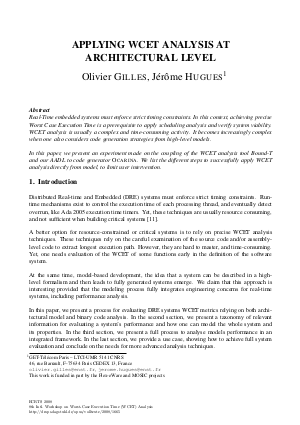Applying WCET Analysis at Architectural Level
Authors Olivier Gilles, Jérôme Hugues
-
Part of:
Volume:
8th International Workshop on Worst-Case Execution Time Analysis (WCET'08) (WCET 2008)
Part of: Series: Open Access Series in Informatics (OASIcs)
Part of: Conference: Workshop on Worst-Case Execution Time Analysis (WCET) - License:
 Creative Commons Attribution-NonCommercial-NoDerivs 3.0 Unported license
Creative Commons Attribution-NonCommercial-NoDerivs 3.0 Unported license
- Publication Date: 2008-11-13
File

PDF
OASIcs.WCET.2008.1665.pdf
- Filesize: 159 kB
- 9 pages
Document Identifiers
Subject Classification
Keywords
- WCET
- AADL
- Bound-T
- Ocarina
Metrics
- Access Statistics
-
Total Accesses (updated on a weekly basis)
0Document
0Metadata
Abstract
Real-Time embedded systems must enforce strict timing constraints. In this context, achieving precise Worst Case Execution Time is a prerequisite to apply scheduling analysis and verify system viability. WCET analysis is usually a complex and time-consuming activity. It becomes increasingly complex when one also considers code generation strategies from high-level models. In this paper, we present an experiment made on the coupling of the WCET analysis tool Bound-T and our AADL to code generator OCARINA. We list the different steps to successfully apply WCET analysis directly from model, to limit user intervention.
Cite As Get BibTex
Olivier Gilles and Jérôme Hugues. Applying WCET Analysis at Architectural Level. In 8th International Workshop on Worst-Case Execution Time Analysis (WCET'08). Open Access Series in Informatics (OASIcs), Volume 8, pp. 1-9, Schloss Dagstuhl – Leibniz-Zentrum für Informatik (2008)
https://doi.org/10.4230/OASIcs.WCET.2008.1665
BibTex
@InProceedings{gilles_et_al:OASIcs.WCET.2008.1665,
author = {Gilles, Olivier and Hugues, J\'{e}r\^{o}me},
title = {{Applying WCET Analysis at Architectural Level}},
booktitle = {8th International Workshop on Worst-Case Execution Time Analysis (WCET'08)},
pages = {1--9},
series = {Open Access Series in Informatics (OASIcs)},
ISBN = {978-3-939897-10-1},
ISSN = {2190-6807},
year = {2008},
volume = {8},
editor = {Kirner, Raimund},
publisher = {Schloss Dagstuhl -- Leibniz-Zentrum f{\"u}r Informatik},
address = {Dagstuhl, Germany},
URL = {https://drops.dagstuhl.de/entities/document/10.4230/OASIcs.WCET.2008.1665},
URN = {urn:nbn:de:0030-drops-16653},
doi = {10.4230/OASIcs.WCET.2008.1665},
annote = {Keywords: WCET, AADL, Bound-T, Ocarina}
}
